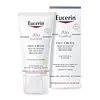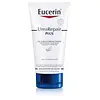What's inside
What's inside
 Key Ingredients
Key Ingredients

 Benefits
Benefits

 Concerns
Concerns

 Ingredients Side-by-side
Ingredients Side-by-side

Water
Skin ConditioningGlycerin
HumectantVitis Vinifera Seed Oil
EmollientOenothera Biennis Oil
EmollientCaprylic/Capric Triglyceride
MaskingCyclomethicone
EmollientDimethicone
EmollientPentaerythrityl Tetraisostearate
EmollientTriisostearin
Skin ConditioningCetyl Alcohol
EmollientGlyceryl Stearate
EmollientPEG-40 Stearate
EmulsifyingGlycyrrhiza Inflata Root Extract
Skin ConditioningCeramide NP
Skin ConditioningTocopherol
AntioxidantCitric Acid
BufferingSodium Citrate
BufferingAscorbyl Palmitate
AntioxidantBHT
Antioxidant1,2-Hexanediol
Skin ConditioningPhenoxyethanol
PreservativePiroctone Olamine
PreservativeWater, Glycerin, Vitis Vinifera Seed Oil, Oenothera Biennis Oil, Caprylic/Capric Triglyceride, Cyclomethicone, Dimethicone, Pentaerythrityl Tetraisostearate, Triisostearin, Cetyl Alcohol, Glyceryl Stearate, PEG-40 Stearate, Glycyrrhiza Inflata Root Extract, Ceramide NP, Tocopherol, Citric Acid, Sodium Citrate, Ascorbyl Palmitate, BHT, 1,2-Hexanediol, Phenoxyethanol, Piroctone Olamine
Water
Skin ConditioningGlycerin
HumectantUrea
BufferingDibutyl Adipate
EmollientGlyceryl Stearate
EmollientStearyl Alcohol
EmollientDicaprylyl Ether
EmollientCetearyl Alcohol
EmollientSodium Lactate
BufferingTapioca Starch
Glyceryl Stearate Se
EmulsifyingCeramide NP
Skin ConditioningLactic Acid
BufferingArginine Hcl
Skin ConditioningSodium PCA
HumectantCholesterol
EmollientHelianthus Annuus Seed Oil
EmollientAlanine
MaskingCarnitine
CleansingGlycine
BufferingSodium Chloride
MaskingDimethicone
EmollientXanthan Gum
EmulsifyingSodium Cetearyl Sulfate
CleansingDecylene Glycol
Skin ConditioningPhenoxyethanol
PreservativePentylene Glycol
Skin ConditioningWater, Glycerin, Urea, Dibutyl Adipate, Glyceryl Stearate, Stearyl Alcohol, Dicaprylyl Ether, Cetearyl Alcohol, Sodium Lactate, Tapioca Starch, Glyceryl Stearate Se, Ceramide NP, Lactic Acid, Arginine Hcl, Sodium PCA, Cholesterol, Helianthus Annuus Seed Oil, Alanine, Carnitine, Glycine, Sodium Chloride, Dimethicone, Xanthan Gum, Sodium Cetearyl Sulfate, Decylene Glycol, Phenoxyethanol, Pentylene Glycol
 Reviews
Reviews

Ingredients Explained
These ingredients are found in both products.
Ingredients higher up in an ingredient list are typically present in a larger amount.
Ceramide NP is a type of ceramide and formally known as ceramide 3.
Ceramides are intercellular lipids naturally found in our skin that bonds dead skin cells together to create a barrier. They are known for their ability to hold water and thus are a great ingredient for dry skin.
Ceramides are an important building block for our skin barrier. A stronger barrier helps the skin look more firm and hydrated. By bolstering the skin ceramides act as a barrier against irritating ingredients. This can help with inflammation as well.
If you would like to eat ceramides, sweet potatoes contain a small amount.
Read more about other common types of ceramides here:
Ceramide AP
Ceramide EOP
Dimethicone is a type of synthetic silicone created from natural materials such as quartz.
What it does:
Dimethicone comes in different viscosities:
Depending on the viscosity, dimethicone has different properties.
Ingredients lists don't always show which type is used, so we recommend reaching out to the brand if you have questions about the viscosity.
This ingredient is unlikely to cause irritation because it does not get absorbed into skin. However, people with silicone allergies should be careful about using this ingredient.
Note: Dimethicone may contribute to pilling. This is because it is not oil or water soluble, so pilling may occur when layered with products. When mixed with heavy oils in a formula, the outcome is also quite greasy.
Learn more about DimethiconeGlycerin is already naturally found in your skin. It helps moisturize and protect your skin.
A study from 2016 found glycerin to be more effective as a humectant than AHAs and hyaluronic acid.
As a humectant, it helps the skin stay hydrated by pulling moisture to your skin. The low molecular weight of glycerin allows it to pull moisture into the deeper layers of your skin.
Hydrated skin improves your skin barrier; Your skin barrier helps protect against irritants and bacteria.
Glycerin has also been found to have antimicrobial and antiviral properties. Due to these properties, glycerin is often used in wound and burn treatments.
In cosmetics, glycerin is usually derived from plants such as soybean or palm. However, it can also be sourced from animals, such as tallow or animal fat.
This ingredient is organic, colorless, odorless, and non-toxic.
Glycerin is the name for this ingredient in American English. British English uses Glycerol/Glycerine.
Learn more about GlycerinGlyceryl Stearate is a mix of glycerin and stearic acid.
It is used to stabilize the mixing of water and oil ingredients. By preventing these ingredients from separating, it can help elongate shelf life. It can also help thicken the product's texture.
As an emollient, it helps soften skin and supports barrier-replenishing ingredients.
In cosmetics, Glyceryl Stearate is often made from vegetable oils or synthetically produced.
This ingredient may not be fungal-acne safe
Fun fact: The human body also creates Glyceryl Stearate naturally.
Learn more about Glyceryl StearatePhenoxyethanol is a preservative that has germicide, antimicrobial, and aromatic properties. Studies show that phenoxyethanol can prevent microbial growth. By itself, it has a scent that is similar to that of a rose.
It's often used in formulations along with Caprylyl Glycol to preserve the shelf life of products.
Water. It's the most common cosmetic ingredient of all. You'll usually see it at the top of ingredient lists, meaning that it makes up the largest part of the product.
So why is it so popular? Water most often acts as a solvent - this means that it helps dissolve other ingredients into the formulation.
You'll also recognize water as that liquid we all need to stay alive. If you see this, drink a glass of water. Stay hydrated!
Learn more about Water